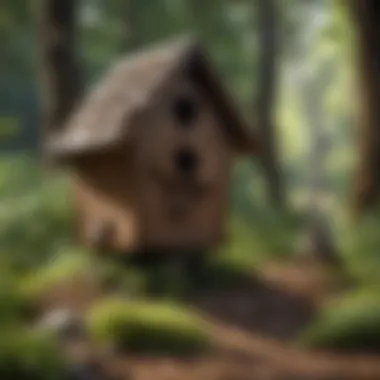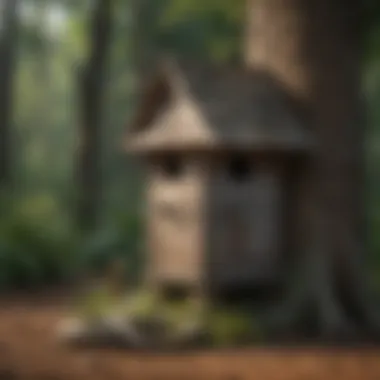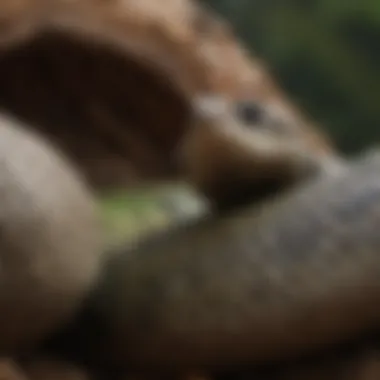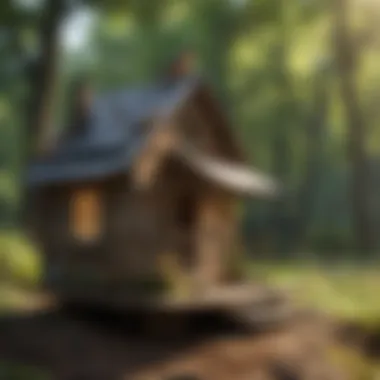Effective Strategies to Protect Bird Houses from Snakes


Intro
Protecting bird houses from snakes can often feel like a daunting task to many bird enthusiasts. Snakes pose a significant threat, especially during the nesting season when birds are most vulnerable. But understanding why snakes are drawn to these spaces can help us create an environment that’s inhospitable to them while ensuring the safety of our feathered friends.
Bird houses are often placed in locations that may seem ideal for birds but can inadvertently attract snakes. Whether it's the insects buzzing around, the warmth of the sun, or even the seeds that fall during feeding times, these factors can create a perfect storm for a snake who’s on the hunt. However, a few strategic adjustments can make all the difference in safeguarding these vital habitats.
In the sections that follow, we will dive into practical strategies that focus on modifying the environment, installing barriers, and understanding local snake behaviors. By the end of this guide, you will feel empowered to successfully protect your avian occupants, ensuring they can thrive safely.
Let’s explore simple yet effective tips to keep snakes at bay.
Understanding the Threat of Snakes
When it comes to the lush world of birdhouses, many enthusiasts may not stop to ponder the lurking dangers from snakes. These slender, slithery creatures often receive a bad rap, but they play a vital role in our ecosystems. However, their presence can spell disaster for vulnerable bird species trying to nest in our backyards.
This section sheds light on the significance of understanding the threat that snakes pose to birdhouses while exploring specific elements that contribute to this concern. Recognizing the existence of snakes and our local species can empower bird owners to take informed actions to protect their feathered companions. Moreover, comprehension of snakes’ behaviors, habitats, and food preferences lays the groundwork for developing effective safeguarding techniques.
The Role of Snakes in Ecosystems
Snakes often get a bad reputation as mindless predators. In fact, they are critical players in the ecosystem. By controlling rodent populations, snakes help maintain balance in their habitats. For instance, a study might reveal that certain snakes reduce the number of field mice; thus, fewer mice mean less chance for larger predators, which helps local bird populations thrive.
- Snakes regulate prey populations, allowing bird species to flourish.
- They serve as food for larger predators, creating a cycle of life crucial for biodiversity.
- Their adaptability to various habitats showcases nature’s intricate balance.
Understanding this blend of roles can help bird enthusiasts respect, rather than fear, snakes in their environment. This recognition is key, as snakes are often simply fulfilling their ecological duties while living alongside our avian friends.
Common Snake Species in Bird Nesting Areas
Identifying snake species that frequent bird nesting areas is essential for crafting strategies to protect birdhouses. Depending on geography, several snakes may inhabit your local vicinity. Familiarity with these species can aid in comprehending potential threats.
Some common culprits include:
- Garter Snakes: Often seen as harmless, but can prey on small birds.
- Rat Snakes: Known for climbing trees, they pose a significant threat to nests.
- Black Racers: Fast and agile, they can dart into nesting spaces swiftly.
Even though many snakes are harmless to humans, their predatory instincts may spell trouble for birds. Hence, knowing your local snake population is a steppingstone towards safeguarding birdhouses.
Behavioral Patterns of Snakes
Understanding how snakes behave is pivotal in protecting birdhouses. Snakes often have specific patterns that can guide bird owners on how to deter them. For example, many species prefer areas with plenty of cover like tall grass or thick shrubs. Addressing these elements in your garden could make all the difference.
Common behaviors to observe include:
- Hunting Patterns: Snakes often hunt during dawn and dusk. Awareness of these times can prompt vigilance.
- Shedding Skin: A tell-tale sign of snake presence, skin left in the yard can indicate a nearby snake.
- Territorial Behavior: Some species establish a home range. Identifying these areas can be key in avoiding conflicts.
Monitoring these behaviors is crucial for implementing strategies that safeguard birdhouses without harming the snakes themselves.
Understanding the threats posed by snakes not only ensures the safety of nesting birds but also enhances appreciation for the natural world. With the right knowledge, we can co-exist respectfully, ensuring that both birds and snakes thrive in the landscapes we cherish.
Identifying Attractions for Snakes
Understanding what draws snakes to your garden or property is a critical step in protecting bird houses. By continuing to observe and evaluate these attractions, homeowners can proactively minimize snake encounters and create a safer nesting environment for birds. Several distinctive elements combine to create a perfect storm that can lure snakes, so recognizing these factors is essential.
Environmental Factors that Lure Snakes
Snakes are often considered the yard's quiet observers, relying heavily on environmental factors to determine where they go. One of the significant draws for snakes is a warm, sunny spot where they can bask. Properties with patches of bare ground or stones, which absorb sunlight, often become a hotbed for snake activity.


Moreover, moist areas are also attractive to snakes, as these places are rich in prey. If you have a drainage ditch, pond, or even an area where water collects after rain, you may inadvertently be inviting snakes into your backyard. Keeping these areas clean and well-maintained can affect the likelihood of a snake's presence.
Prey Availability Near Bird Houses
An often overlooked detail is the availability of food. Snakes are opportunists, and where there’s food, there’s a snake. Small rodents, like mice or voles, are favorites of many snakes. If these critters find attractive habitats near your bird houses—like thick underbrush or overgrown grass—snakes will not be far behind.
To reduce the chances of attracting these rodents, keep the area around the bird houses clear of any potential food sources. This includes fallen seeds from bird feeders and refuse that might gather under bushes. Regularly checking and maintaining cleanliness can keep both your bird houses and nesting birds safe.
Shelter and Climate Preferences
Snakes thrive in specific climatic conditions; knowing these can help in their deterrence. Most species prefer a warm and humid environment, hiding in thickets, under logs, or debris during the day to escape heat. If you provide too many hiding spots—like piles of leaves, wood, or stones—your chances of attracting snakes increases.
In addition to this, every snake has its own preferred habitat. Some common types may prefer open fields, while others like tree cover. Understanding which species are common in your area can inform your modifications, such as trimming back overgrown areas or removing unnecessary debris that serves as snake harborage.
"A well-kept garden is not only beautiful but can also thwart potential snake invitations."
Preventive Measures for Bird House Protection
When it comes to safeguarding bird houses from the persistent threat of snakes, taking preventive measures is your first line of defense. The discussion surrounding protective strategies is not just about safeguarding the bird houses, but also about ensuring that your winged companions can thrive without fear. Such measures not only protect the birds but also enhance the overall ecological balance in your backyard or garden.
Choosing the Right Location
The location of a bird house can determine its vulnerability to snake visits. A bird house placed under overhanging branches or near dense vegetation can inadvertently invite snakes closer. Careful selection of the spot can be the difference between life and potential predation. Aim for a location where snakes are less likely to roam, which generally includes open spaces or areas with a bit more sunlight.
Consider factors like distance from rocky areas or wood piles. Snakes often lurk in such habitats. Placing the bird house at least ten feet away from these locations can significantly reduce the chances of snake encounters. Additionally, elevating the bird house can also provide an extra layer of safety; a height of at least five to six feet off the ground is typically ideal.
Using Physical Barriers
Physical barriers serve as a concrete line of defense against unwanted intruders. One simple yet effective method is to surround the bird house with fencing. Using wire mesh of a small gauge, this fencing can deter snakes from accessing the bird houses. Not only does it block entry, but it can also discourage snakes from slithering too close.
It’s important to ensure that any fencing is securely fastened to the ground. Snakes are adept at finding weaknesses. A barrier that is less sturdy could be an open invitation for them. Adding a few additional inches of wire mesh underground can deter burrowing snakes as well.
Tip: Regularly check the integrity of your barriers and make adjustments as needed, especially after storms or heavy winds that might disturb their placement.
Designing Bird Houses with Snake Deterrents
Incorporating design features into bird houses can enhance their protective capabilities. Using materials that are less appealing to snakes, like smooth, slick surfaces, can make it difficult for them to climb. Avoid using wood with rough textures or surfaces, as these can offer snakes easier grip.
Equipping the entrance with an appropriate size hole can also limit access. A smaller opening may permit birds while preventing larger snakes from squeezing inside. Additionally, adding designs that make climbing less feasible, such as sloped roofs, can further discourage persistent snakes.
In some cases, adding a snake guard—available at many hardware and gardening stores—around the entrance can act as an extra layer of security.
Bird owners who are keen on taking that extra step can also paint or coat the bird house in bright colors. While this might not stop them outright, it can draw attention without the need for camouflage, making the house a less appealing target.
In summary, preventive measures hold the key to ensuring bird houses remain safe havens for your feathered friends. By taking the right steps in choosing locations, employing physical barriers, and designing with care, you can create an environment that helps protect against the threat of snakes.
Habitat Modification Techniques
When it comes to safeguarding bird houses from snakes, habitat modification techniques are vital strategies that can help create an inhospitable environment for these reptiles. By carefully altering the surroundings of your bird houses, one can not only deter snakes but also promote a healthier ecosystem that benefits both avian and terrestrial wildlife. Let's delve into the various ways to achieve this.
Landscaping for Snake Deterrence
Creating a snake-free zone around bird houses involves more than just aesthetics; it’s about smart landscaping choices. Snakes often seek out areas with dense cover and rich vegetation to hide from predators and stalk their prey. Consider the following landscaping practices:


- Opt for Open Spaces: Mow grass regularly and create open airways around bird houses. This reduces cover for snakes, making it less likely for them to approach.
- Use Thorny Shrubs: Planting bushes with thorns or spines can act as a natural barrier. These shrubs deter snakes by making the area uncomfortable for them to traverse.
- Incorporate Mulching: Utilizing coarse mulch can also help. Unlike soft, densely-packed materials that can harbor snakes, chunky mulch discourages their presence.
By transforming landscaping into a snake-unfriendly area, you enhance bird safety while keeping your yard visually appealing.
Removing Potential Hiding Spots
Each nook and cranny in your yard can become a sanctuary for snakes. Identifying and eliminating these hiding spots is crucial. Consider these actions:
- Clear Debris Regularly: Remove piles of leaves, wood stacks, and other debris where snakes might slither in for a nap. Keeping your space tidy assures less opportunity for them to hide.
- Control Rock and Stone Features: Look for decorative stone features or rock gardens. While they might enhance the visual aspect of your garden, they can be perfect snake havens. Burnish up their locations regularly to limit potential snake sightings.
- Limit Moist Areas: Snakes are drawn to moisture. Ensure any low-lying areas or puddles are well-drained and dry. This discourages snakes from lounging about.
Implementing these measures allows bird houses to thrive in a less appealing environment for snakes.
Maintaining Healthy Surrounding Habitats
While it may seem counterintuitive, creating a balanced ecosystem can actually help control snake populations. A healthy habitat will support natural predators of snakes, such as certain birds of prey. Here’s how:
- Encourage Local Wildlife: Plant a variety of native plants that attract beneficial insects and birds. This, in turn, attracts raptors that can help keep snake numbers in check.
- Diversity is Key: Maintain a diversity of plant species. Monocultures can lead to imbalances in the ecosystem that allow snake populations to grow unchecked.
- Proper Waste Management: Keep the area free from food scraps and garbage that could attract rodents and lizards—snakes’ primary food sources. Without a steady food supply, snake visits to your bird houses will be reduced.
In summary, successful habitat modification involves a combination of smart landscaping, the removal of hiding places, and fostering a balanced ecosystem. These techniques contribute not only to the safety of your bird houses but also the health of the entire habitat, ensuring a flourishing environment for nature and wildlife.
"An ounce of prevention is worth a pound of cure."
Using these proactive tactics ensures the birds in your care are protected against unwanted serpentine visitors.
Monitoring and Early Detection
Monitoring and early detection play vital roles in keeping bird houses safe from snakes, ensuring that nesting birds can thrive without unnecessary disturbances. These strategies are not just precautionary; they are integral to developing a proactive stance against potential snake invasions. By routinely checking for signs of snake activity and utilizing technology for surveillance, bird enthusiasts can catch discrepancies before they escalate into issues. Knowing when a snake could be lurking can be the difference between a peaceful nesting season and a stressful one.
Regular Inspections for Snake Activity
Conducting regular inspections of bird houses is essential to ensure that snakes aren’t getting too comfortable in the vicinity. Think of it like going to the doctor for a check-up; you want to catch any problems before they snowball into something serious. When inspecting, pay close attention to:
- Signs of Slithering: Look for shed skins, feces, and track marks in the dirt, which can indicate nearby snake activity.
- Structural Integrity: Ensure that there are no gaps or holes in bird houses where snakes might find their way in.
- Proximity to Underbrush: Snakes love dense foliage; if your bird house is near thick brush, snakes may be lurking nearby.
Setting a schedule for these inspections—perhaps weekly during peak nesting seasons—will keep you well-informed. If you notice any signs of snake activity, act swiftly. Sometimes, a simple shift in location or barrier enhancement can make a world of difference.
Utilizing Wildlife Cameras
Incorporating wildlife cameras into your bird monitoring strategy offers an innovative twist to observing potential threats. These cameras can provide real-time footage and serve as an early warning system. To maximize their effectiveness:
- Positioning Matters: Place the cameras at strategic points near your bird houses where you suspect snake activity, perhaps at angles that cover surrounding flora.
- Night Vision Features: Look for cameras equipped with night vision capabilities, as some snakes are nocturnal and may not be active during the day.
- Routine Check-Ins: Regularly review the footage—as distinct movements or behaviors can help you gauge the types of wildlife interacting with your space.
Using tech gadgets like wildlife cameras not only brings peace of mind but also allows for consistent monitoring without constant physical presence. For those not well-versed in technical aspects, there are many community forums, such as Reddit, where bird enthusiasts share experiences and tips about camera setups that work best.
Coexistence Strategies with Local Wildlife
Understanding how to live alongside the local wildlife, including snakes, is essential for bird owners. While the need to protect bird houses is paramount, ignoring the role of other creatures in the ecosystem can lead to an imbalance that ultimately harms our feathered friends. A comprehensive approach to coexistence involves recognizing the benefits of local wildlife, including snakes, and how respectful interactions can support a healthier environment.
Understanding the Balance of Nature
At first glance, snakes might seem like a direct threat to birds and their nests. However, these reptiles play an integral role in maintaining ecological balance. Snakes help control the population of rodents, which can be detrimental to bird eggs and even adult birds. It's important to recognize that the presence of snakes can be beneficial, for they can help keep the pest numbers down without us having to resort to chemical control methods that could harm the entire environment.
Coexistence starts with understanding behaviors. Many snakes are not aggressive unless provoked. They typically prefer to avoid human contact and often retreat when faced with unfamiliar territory. Encouraging their natural prey can deter them from entering bird nesting areas while still allowing them to flourish. An example would be maintaining a well-balanced ecosystem with plenty of vegetation, insects, and small mammals. This approach emphasizes that attracting desirable wildlife helps keep snakes at a distance, allowing birds to thrive in their nests.


Education and Community Outreach
Knowledge is power, especially when dealing with wildlife. Educating yourself and your community about local snakes is a critical strategy for coexistence. Many organizations offer workshops, distribute informational pamphlets, and even hold community events focused on wildlife management.
Initiatives can include the following:
- Workshops: Invite wildlife experts to share insights into local species and their role in the ecosystem.
- Information Sessions: Host Q&A sessions where people can voice concerns about snakes and learn practical ways to coexist.
- Community Newsletters: Share tips and success stories about living alongside local wildlife. This helps change perceptions and encourages cooperation.
As a bird owner, participating in such outreach can lead to a cohesive community approach to wildlife conservation. It fosters respect and understanding while reducing fear-based reactions toward snakes. Additionally, it allows for the exchange of ideas on how to build safer habitats for birds that coexist with snakes.
Educating children about local wildlife is also essential. Schools can implement programs focused on the importance of biodiversity, instilling a sense of appreciation for all creatures, no matter how intimidating they may seem.
"Education is not the filling of a pail, but the lighting of a fire."
– William Butler Yeats
By fostering dialogue and education surrounding snakes, we can help our communities become more bird-friendly while embracing the natural order. Species like the Eastern Rat Snake or the Garter Snake might not pose a threat to our birds if we understand their habitats and behaviors better.
In summary, thriving relationships with local wildlife require ongoing education and mutual respect. Embracing coexistence benefits both our beloved birds and the essential roles snakes play in the environment.
When to Seek Professional Help
In managing the delicate balance between bird conservation and snake presence, certain situations might arise where your do-it-yourself efforts are no longer enough. Recognizing when to turn to professionals can make a world of difference, not only for your nesting birds but also for the local ecosystem. If the task seems overwhelming or the stakes are high, seeking assistance is not just an option; it’s often a necessity.
Identifying a Snake Infestation
The first step in determining if professional help is needed involves assessing whether a snake infestation is present. Signs of snake activity are often subtle, necessitating a keen eye. These include:
- Shedding skins around the garden or near bird houses.
- Tracks in the dirt, especially if the soil's soft enough to leave impressions.
- Unusual bird behavior—like constant alarm calls or sudden absences, which may hint at snake predation.
- Frequent sightings near the structure or backyard.
A snake infestation isn't always immediately apparent, which is why regular checks are vital. If you observe multiple signs over a short period, it's prudent to err on the side of caution.
Engaging a wildlife expert can benefit you. They possess tools and the experience necessary to conduct a thorough inspection, providing a detailed assessment of the situation. Professional evaluations often uncover hidden issues you might overlook, saving your birds from potential harm.
Finding Qualified Wildlife Removal Services
Once you've assessed the potential for a snake infestation, the next step is to locate qualified wildlife removal services suitable for your needs. However, not all services are created equal. Here are some tips to ensure you find a competent one:
- Look for certifications: Check if the service has credentials from organizations focused on wildlife management. This indicates they follow best practices in handling such situations.
- Research local reviews: Websites like Facebook and Reddit can provide insights into customers’ experiences. Positive reviews from fellow bird enthusiasts can give you confidence in their competence.
- Inquire about humane methods: Ensure that the removal service prioritizes humane practices—some companies may adopt inhumane techniques that could harm the snakes or larger ecosystems.
- Ask about follow-up measures: An effective service isn't just about removal; they should also provide advice on safeguarding your property against future infestations.
"Choosing wisely could mean the difference between a safe environment for your birds and a lingering snake presence."
Navigating a snake issue can be daunting, but by observing the signs and reaching out for expert guidance, you can secure a safer area for your feathered friends. Being proactive and informed transforms potential fears into practical actions.
Ending
In this article, we have explored the pressing issue of how to effectively safeguard bird houses from snakes, a concern that resonates deeply with bird lovers and conservationists alike. The importance of this topic cannot be overstated. Bird houses serve as crucial shelters for numerous species, allowing them to thrive and reproduce in safe environments. However, without proper precautions, these safe havens can quickly become hunting grounds for snakes. This is not only detrimental to the birds but also disrupts the ecosystem balance.
Recap of Key Strategies
To ensure the protection of bird houses, several strategies have been highlighted throughout the article. Here is a succinct recap of these methods:
- Choosing the Right Location: Placing bird houses in open areas, away from dense vegetation where snakes may hide.
- Using Physical Barriers: Employing protective measures like wire mesh around the bird houses to deter snakes from access.
- Landscaping for Snake Deterrence: Keeping the surrounding area well-maintained to remove potential snake habitats.
- Regular Inspections: Conducting routine checks to spot any signs of snake activity early.
- Utilizing Wildlife Cameras: Setting up cameras can help monitor any movements around the bird houses, alerting you to threats.
- Seeking Professional Help: If snake infestations occur, it’s vital to find qualified wildlife removal services to address the situation responsibly.
Incorporating these strategies isn’t just wise; it’s essential to ensure the survival of our feathered friends in a shared habitat.
Promoting Bird Conservation
Protecting bird houses extends beyond just safeguarding individual nests; it is an integral part of broader conservation efforts. Snakes naturally play a role in the ecosystem, but it is crucial to find ways that maximize coexistence. By implementing the strategies discussed, we not only shield birds from the direct threats of predation, but we also contribute to fostering healthier populations of both birds and snakes. Creating awareness about such strategies also encourages community involvement in wildlife conservation initiatives.
It’s advisable to engage with local wildlife organizations, sharing knowledge and strategies learned, as it benefits everyone. Not only does it lead to more informed communities, but it also helps in creating a viable balance in our ecosystems.
As responsible stewards of the environment, every little effort can create ripple effects that support wildlife conservation and enhance natural habitats for generations to come.















